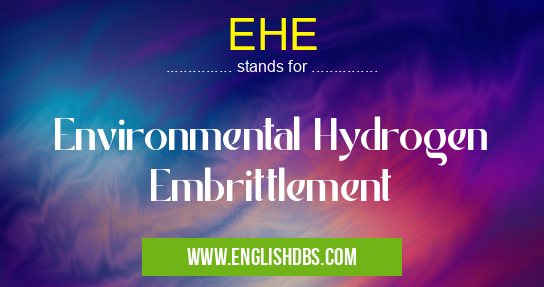What does EHE mean in CHEMISTRY
Environmental Hydrogen Embrittlement (EHE) is a phenomenon in which hydrogen atoms diffuse into a material, such as steel or aluminum, and then combine with the material’s free electrons to create a reaction that causes the material to become brittle. This can lead to fracturing or cracking of the metal and potentially catastrophic failure of components or systems made from that material. EHE is caused by many factors, including corrosion, corrosive environments, improper heat treating of alloys, hydrogen gas impurities and mechanical stress. It is an important factor to consider in industries such as aerospace engineering, automotive engineering and energy production where components are exposed to aggressive environments or are subjected to high stress loads.

EHE meaning in Chemistry in Academic & Science
EHE mostly used in an acronym Chemistry in Category Academic & Science that means Environmental Hydrogen Embrittlement
Shorthand: EHE,
Full Form: Environmental Hydrogen Embrittlement
For more information of "Environmental Hydrogen Embrittlement", see the section below.
Explanation
The process of Environmental Hydrogen Embrittlement begins when small molecules of hydrogen diffusion into the metal structure causing it to become brittle and prone to breaking. The small molecules are attracted to free electrons within the metals surface forming a kind of lattice resulting from chemical reactions between them. These lattices weaken the materials structure creating stress concentrations increasing the likelihood for fracture. The rate of embrittlement will vary depending on several factors such as steels hardness, thickness, grain size/structure and applied tensile force making it difficult to predict exact results. Additionally EHE is affected by environmental factors like temperature and humidity making it even more unpredictable.
Essential Questions and Answers on Environmental Hydrogen Embrittlement in "SCIENCE»CHEMISTRY"
What is Environmental Hydrogen Embrittlement (EHE)?
Environmental Hydrogen Embrittlement (EHE) is a phenomenon that occurs when hydrogen enters the microstructure of metals, resulting in cracking and premature failure. The embrittling process often occurs when metallic components are exposed to certain types of corrosive environments, particularly those containing hydrogen gas or its compounds.
What kind of environment can cause EHE?
EHE mainly occurs in environments which have high levels of moisture or corrosion such as seawater, acids, alkalis, and organic chemicals. In addition, some environments can expose metals to high levels of hydrogen gas or its compounds which can cause EHE.
Which metals are the most vulnerable to EHE?
Metals that are prone to environmental hydrogen embrittlement include iron-based steels and alloys such as stainless steel and nickel-based superalloys like Hastelloy. Certain aluminum alloys may also be susceptible to EHE if exposed to certain environments for an extended period of time.
Are there any other factors that can contribute to EHE?
Yes, external stress loads caused by operating conditions such as temperature changes or vibration can also contribute to environmental hydrogen embrittlement. Additionally, certain treatments used on metals such as acid baths and pickling processes may also increase the susceptibility for EHE.
How Can You Identify Parts Susceptible To Environmental Hydrogen Embrittlement (EHE)?
Some parts may show signs of brittleness before failing due to cracks along metal surfaces or discoloration on parts. However, to identify parts susceptible to environmental hydrogen embrittlement more accurately would require testing such as hardness tests using a Rockwell scale in combination with data from chemical analyses and metallurgical studies conducted on the part itself.
What Happens Once The Parts Have Been Identified As Susceptible To EHE?
Once the parts have been identified as susceptible to EHE it is essential that steps are taken to prevent further damage which could lead to failure over time. This could include changing specific operational parameters such as removing stress points or making sure that the component is not exposed to potentially hazardous materials/environments for long periods of time.
Is There Any Way To Treat Materials That Are Impacted By Environmental Hydrogen Embrittlement (EHE)?
It is possible to treat materials affected by environmental hydrogen embrittlement by applying new coatings which help reduce permeability from outside elements into the microstructure reducing further potential damage caused by EHE. Additionally, options may be available where it is possible to replace certain elements within the material composition with others that provide greater resistance against corrosion and other forms of external influences which could cause damage.
Can Materials Be Tested For Resistance Against Environmental Hydrogen Embrittlement (EHE)?
Yes there are several tests available depending on the type of material being tested but these tests generally involve measuring how much force it takes for materials break under applied stress compared with normal materials not subjected exposure which has been known to induce environmental hydrogen embrittlement.
Final Words:
Environmental Hydrogen Embrittlement is an important consideration in industries that make use of metal products that could be potentially exposed to harsh conditions or put under high mechanical stress loads since component failure due to EHE can have fatal consequences. Prevention measures should be taken when designing metal components by considering their environment while also ensuring proper maintenance afterwards so vulnerable parts can be identified quickly before any potential problems arise.
EHE also stands for: |
|
| All stands for EHE |
